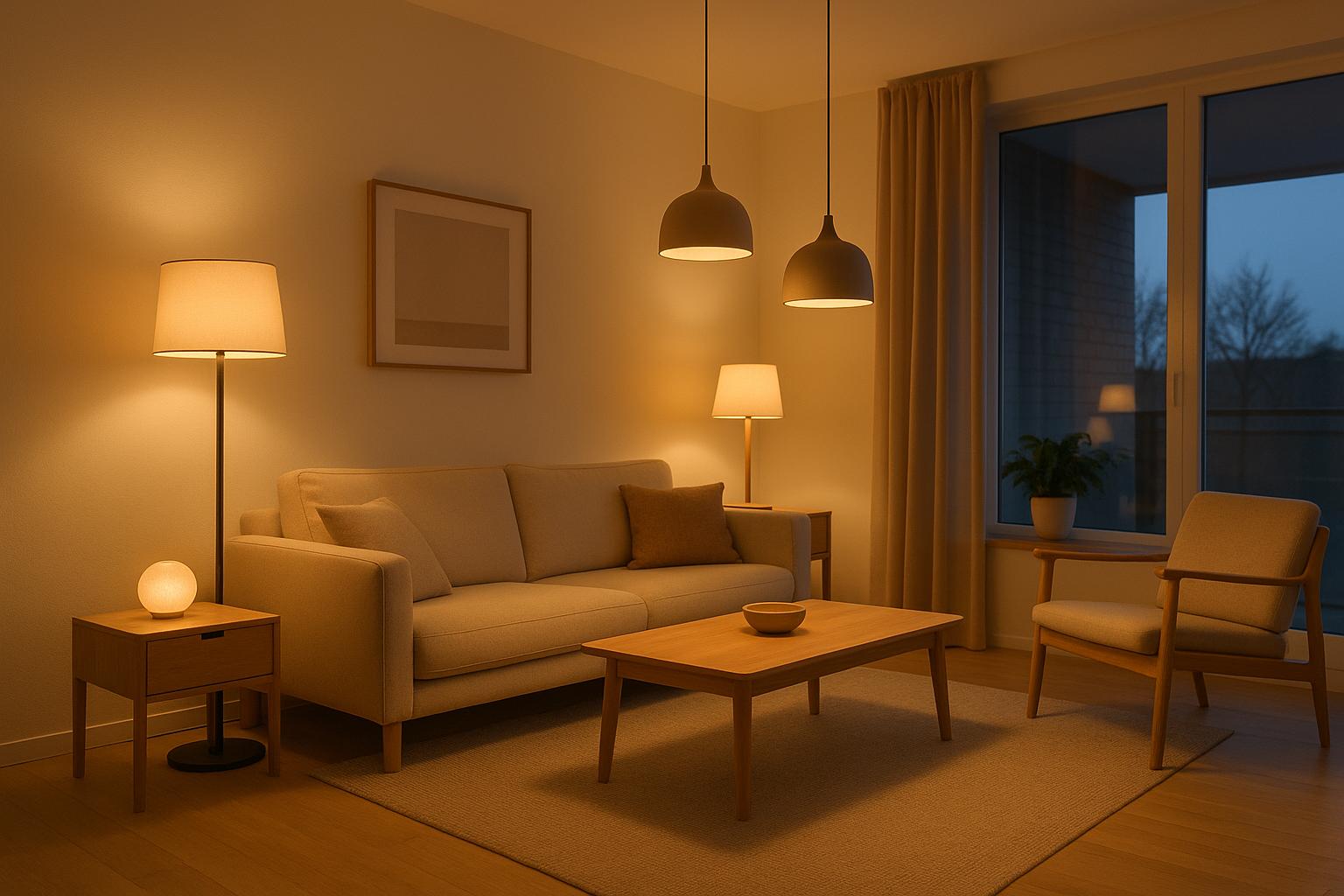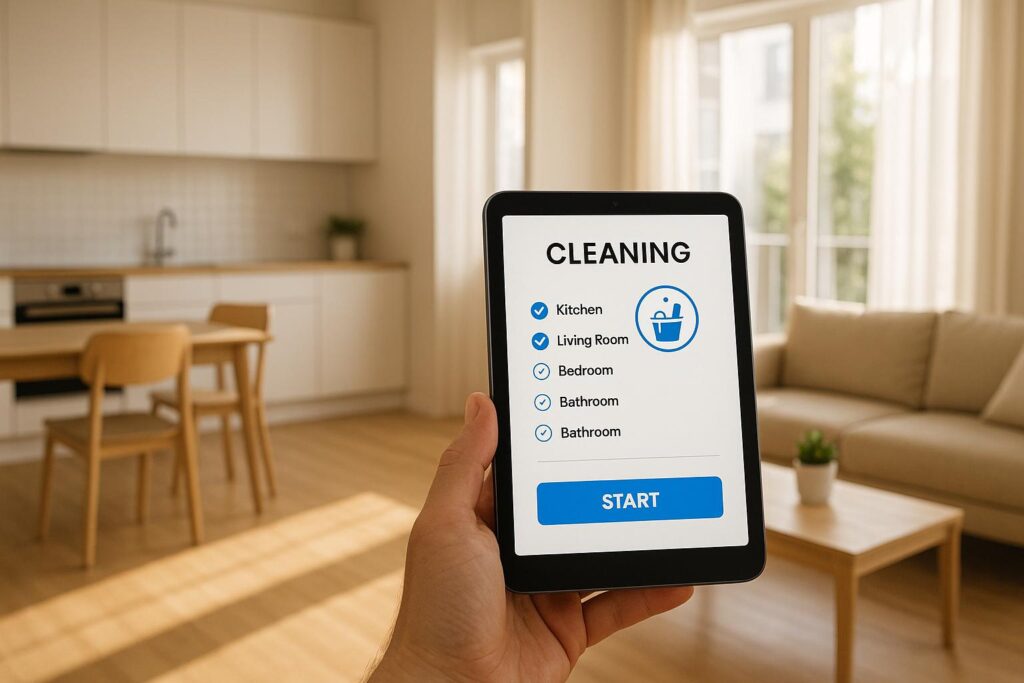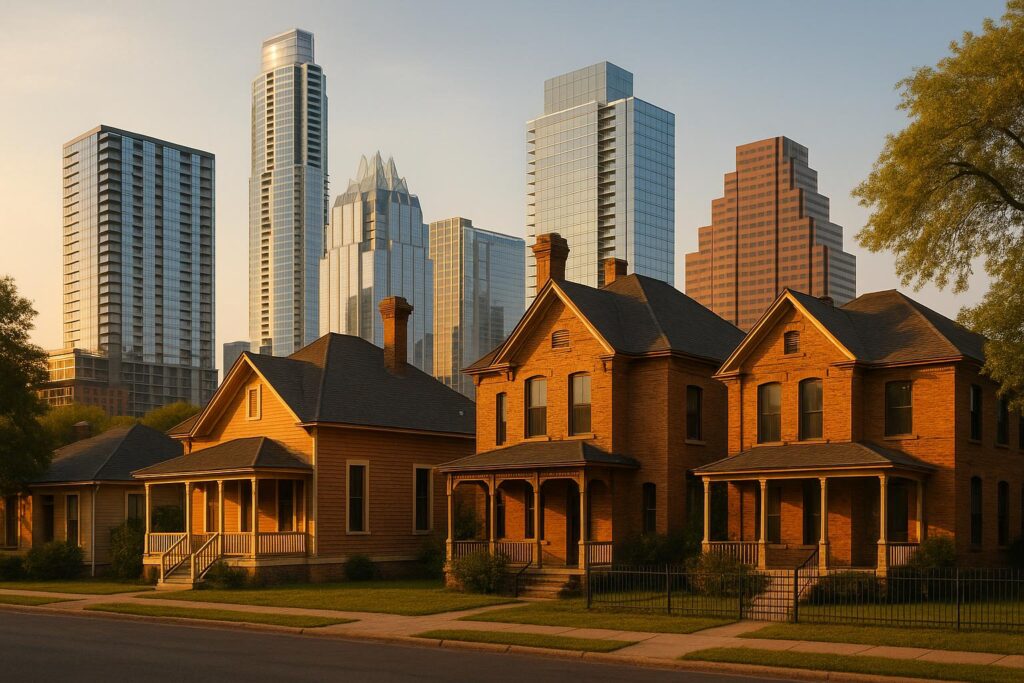Switching to energy-efficient lighting can save you money, reduce power usage, and improve your home’s lighting quality. Here’s what you need to know to get started:
- LED bulbs use 75% less energy than traditional incandescent bulbs and last up to 25,000 hours.
- CFL bulbs consume 70% less energy but contain mercury and take longer to brighten.
- Smart lighting systems combine LEDs with advanced controls like dimming, scheduling, and occupancy sensing to save an additional 10-15% on energy.
Why It Matters:
- Save on bills: LEDs cost around $1.44/year (vs. $7.20 for incandescent).
- Eco-friendly: Long lifespans mean less waste.
- Smarter options: Adjust brightness and color via apps or voice commands.
Quick Tips:
- Replace incandescent bulbs with LEDs for immediate energy savings.
- Choose lighting based on room purpose – e.g., warm LEDs for living areas, daylight-balanced LEDs for workspaces.
- Use local Austin programs like rebates from Austin Energy to cut costs on upgrades.
Upgrading is easy and cost-effective – start today to enjoy better lighting and lower energy bills.
Types of Energy-Efficient Lights
LED, CFL, and Smart Lights
LED (Light Emitting Diode) bulbs are at the forefront of energy-saving technology. They use about 75% less energy than traditional incandescent bulbs and can last up to 25,000 hours.
CFL (Compact Fluorescent Lamp) bulbs are another energy-saving option, using around 70% less energy than incandescent bulbs and lasting up to 10 times longer. However, they take a few moments to reach full brightness and contain mercury, which requires careful disposal.
Smart lighting systems take efficiency a step further by combining LED technology with advanced controls. With these systems, users can adjust brightness, color temperature, and timing through apps or voice commands. Features like automated scheduling and occupancy sensing can reduce energy use by 10-15%.
Now, let’s explore how specific lighting choices can improve efficiency in indoor and outdoor spaces.
Inside and Outside Lighting
The right lighting for each area of your home can maximize both efficiency and functionality:
Indoor Spaces
- Kitchen: Under-cabinet LED strips (2700K-3000K) for focused, warm lighting.
- Living Areas: Dimmable LEDs (800-1100 lumens) to create a cozy atmosphere.
- Bathrooms: LED fixtures with a high CRI (90+) for accurate color rendering.
- Home Office: Daylight-balanced LEDs (5000K) to reduce eye strain and improve focus.
Outdoor Spaces
- Security Lights: Motion-sensor LED floodlights (2000+ lumens) for safety and energy savings.
- Landscape Lighting: Low-voltage LED path lights (12V) to highlight walkways and gardens.
- Porch Lights: Dusk-to-dawn LED fixtures for convenience and efficiency.
Light Bulb Comparison
| Feature | LED | CFL | Traditional Incandescent |
|---|---|---|---|
| Average Lifespan | 25,000 hours | 10,000 hours | 1,200 hours |
| Energy Usage (60-Watt equivalent) | 8-12W | 13-15W | 60W |
| Annual Energy Cost* | $1.44 | $2.40 | $7.20 |
| Upfront Cost | $2-8 | $2-4 | $1-2 |
| Color Options | Extensive | Limited | Limited |
| Instant On | Yes | No | Yes |
| Dimmable Options | Most | Few | All |
*Based on 3 hours of daily use at Austin’s average electricity rate of $0.11/kWh.
Choosing the right bulb can lower energy bills and improve lighting quality in your home. LEDs stand out as the most efficient option for Austin homes, offering the best mix of performance and cost savings.
Brighten Your Home: Top Energy-Efficient Lighting Options!
Why Switch to Efficient Lighting
Energy-efficient lighting does more than just save you money.
Save on Your Monthly Bills
Using energy-efficient lighting can significantly cut down your electricity bills. These lights consume less power, which means lower utility costs without requiring major lifestyle adjustments. Plus, they help reduce your household’s overall energy consumption.
Lower Energy Usage
LEDs consume much less energy compared to traditional bulbs, which helps lighten the load on the power grid, especially during peak times. Their long lifespan means fewer replacements and less waste, making them a more eco-friendly choice.
Smarter Lighting Options
Modern LED systems come with advanced features like adjustable color temperatures, compatibility with home automation, and smooth dimming. These options allow you to create the perfect lighting for any mood or schedule while keeping energy use in check. With these controls, you can easily customize your lighting to suit your needs.
sbb-itb-4c99469
How to Upgrade Your Lights
Check Your Current Setup
Start by taking stock of your current lighting. Note the types of fixtures you have, the wattage and type of bulbs, and how often each light is used.
Here’s what to record:
- Fixture types (e.g., recessed, pendant, track lighting)
- Bulb types and wattages
- Frequency of use
- Dimmer compatibility, if applicable
Choose New Lights
Select lighting based on the purpose of each room. For example, living areas benefit from warm LEDs (2,700K–3,000K), while workspaces are better suited for cooler LEDs (around 4,000K).
Key factors to consider:
- Room purpose: Task-oriented spaces need brighter, focused lighting, while ambient spaces do better with softer options.
- Fixture compatibility: Make sure the new bulbs fit your fixtures and work with dimmers, if used.
- Light output: Check lumens to compare brightness (e.g., 800 lumens is similar to a 60W incandescent bulb).
- Color rendering: Look for bulbs with a CRI (Color Rendering Index) above 80 for better color accuracy.
Installation Tips
Swapping bulbs is usually a DIY task, but more complex upgrades might require a professional.
For DIY bulb replacements, follow these steps:
- Turn off power: Shut off electricity at the circuit breaker before starting.
- Check compatibility: Ensure the new bulbs match your fixture’s specifications.
- Test the lights: Turn them on to check for flickering or buzzing issues.
If the job involves wiring or advanced upgrades, hire a licensed electrician who knows Austin’s electrical codes. Local contractors specializing in energy-efficient lighting can ensure your installation is safe and up to code.
Once your lights are installed, explore local Austin programs and services to complete your upgrade.
Austin Support and Programs
Once you’ve planned your upgrade, take advantage of local programs and services to make your project as smooth and efficient as possible.
Available Rebates
Austin Energy’s Home Performance with ENERGY STAR® program provides rebates for energy-saving upgrades, including lighting improvements. Additionally, many Austin retailers offer in-store discounts on ENERGY STAR® LED bulbs, with bulk purchase options available for multi-family properties.
Local Installation Experts
When hiring an electrician, look for licensed professionals with a valid Texas electrical contractor license, proper insurance, and bonding. Make sure they have experience with energy-efficient lighting installations and are familiar with Austin Energy codes. It’s a good idea to choose contractors certified by organizations like NAESCO, BPI, or NABCEP, as these certifications reflect expertise in energy-efficient technologies and practices.
For additional help, you can also turn to the Austin Local Team for specialized services.
Austin Local Team Services
The Austin Local Team provides a range of services, including home assessments to identify lighting upgrade opportunities, market analysis to understand how energy upgrades can impact property value, and connections to licensed contractors skilled in energy-efficient installations. They also offer insights into local energy usage patterns and trends.
To get started, schedule a professional energy audit with a contractor approved by Austin Energy. This will help you pinpoint the most cost-effective upgrades for your home.
Next Steps
Why Upgrade Your Lighting?
Switching to updated lighting solutions lowers your energy bills, decreases power consumption, and improves the overall feel of your home. Many modern lighting systems also work effortlessly with smart home technology, making them a practical and stylish choice.
How to Begin
Ready to upgrade your lighting? Here’s how:
- Get Expert Help: Reach out to the Austin Local Team for personalized advice on lighting upgrades tailored to Austin homes.
- Stay Informed: Sign up for the Austin Local Team newsletter to keep up with real estate trends and tips for improving your home’s efficiency.
FAQs
What are the environmental advantages of using LED lighting in Austin homes?
Switching to LED lighting in your Austin home offers several environmental benefits. LEDs are highly energy-efficient, using up to 75% less electricity than traditional incandescent bulbs. This reduced energy consumption helps lower greenhouse gas emissions, which is especially important in a city like Austin that values sustainability and clean energy initiatives.
Additionally, LEDs last significantly longer – often up to 25,000 hours or more – reducing waste from frequently discarded bulbs. Unlike compact fluorescent lights (CFLs), LEDs contain no mercury, making them safer for the environment and easier to dispose of responsibly. By making the switch, you can contribute to a greener Austin while also enjoying lower energy bills.
How do smart lighting systems improve energy efficiency compared to standard LED or CFL bulbs?
Smart lighting systems enhance energy efficiency by allowing greater control over how and when lights are used. Unlike standard LED or CFL bulbs, smart lights can be programmed to turn on or off automatically based on schedules, occupancy, or natural light levels. This reduces unnecessary energy consumption.
Additionally, many smart lighting systems integrate with mobile apps or smart home hubs, enabling you to dim lights remotely or adjust brightness levels to suit your needs. These features, combined with the inherent energy efficiency of LEDs, make smart lighting an excellent choice for reducing energy usage in your home.
How do I choose the best LED bulbs for different rooms in my Austin home?
When selecting LED bulbs for your home, consider the function of each room and the type of lighting you need. For example:
- Living rooms and bedrooms: Opt for warm white LEDs (2700K–3000K) to create a cozy and relaxing atmosphere.
- Kitchens and bathrooms: Use cool white or daylight LEDs (3500K–5000K) for brighter, task-oriented lighting.
- Outdoor spaces: Choose weather-resistant LED bulbs with appropriate brightness (measured in lumens) for safety and visibility.
Additionally, check the bulb’s wattage equivalency to ensure energy efficiency and compatibility with your fixtures. Dimmable LEDs can also provide flexibility in adjusting the ambiance. With Austin’s focus on sustainability, energy-efficient lighting is a smart choice for reducing electricity bills and environmental impact.






